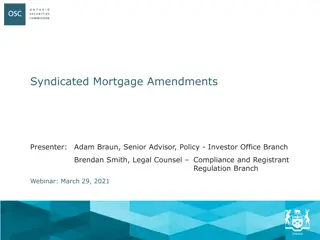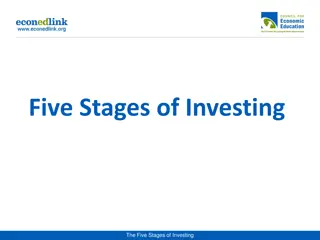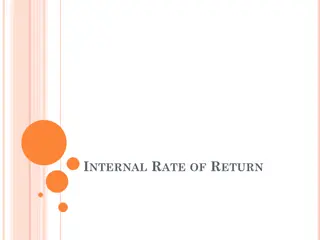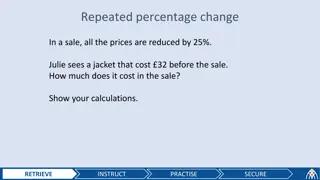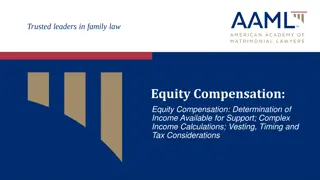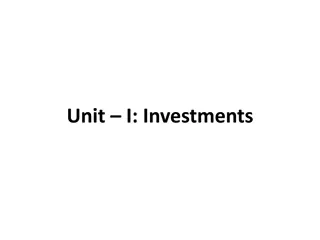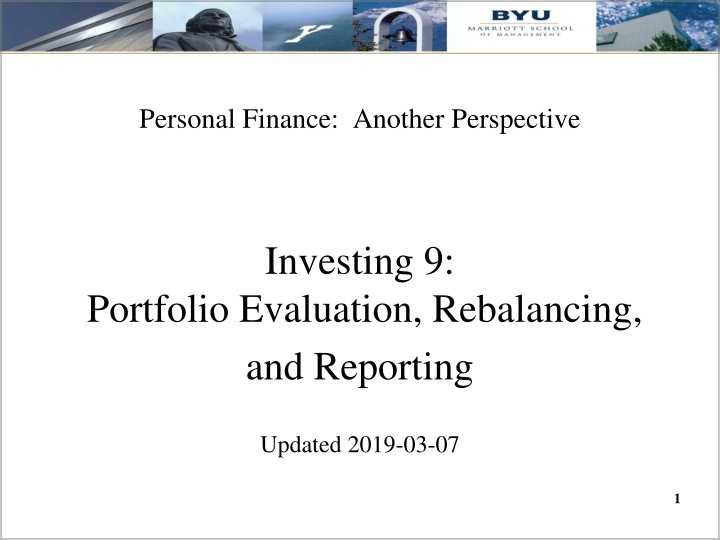
Portfolio Rebalancing and Management
Explore the importance of portfolio rebalancing, evaluation, and reporting in personal finance. Learn about risk-adjusted performance measures, asset allocation, tracking error, and strategies for effective portfolio management.
Uploaded on | 1 Views
Download Presentation

Please find below an Image/Link to download the presentation.
The content on the website is provided AS IS for your information and personal use only. It may not be sold, licensed, or shared on other websites without obtaining consent from the author. If you encounter any issues during the download, it is possible that the publisher has removed the file from their server.
You are allowed to download the files provided on this website for personal or commercial use, subject to the condition that they are used lawfully. All files are the property of their respective owners.
The content on the website is provided AS IS for your information and personal use only. It may not be sold, licensed, or shared on other websites without obtaining consent from the author.
E N D
Presentation Transcript
Personal Finance: Another Perspective Investing 9: Portfolio Evaluation, Rebalancing, and Reporting Updated 2019-03-07 1
Objectives A. Understand portfolio rebalancing B. Understand the importance of portfolio management and performance evaluation C. Understand risk-adjusted performance measures 2 2
Investment Plan Assignments Investments 9: Portfolio Rebalancing and Reporting 1. Determine the type of rebalancing you will likely use and how often you will rebalance, and include it in your investment plan under section IV.B.2 of your Investment Plan (LT05A). 2. Think through the new money/donations addendum, and how you will utilize it to minimize taxes and transactions costs in rebalancing 3. Determine how often you will monitor and report on your portfolio, and include it in IV.A.1. 4. Determine how you will communicate portfolio results and include it in section IV.C. 3 3
Investment Plan Assignments Investments 10: Behavioral Finance 1. There are no required assignments for your Investment Plan from this section 2. Listen and try to determine principles and ways Behavioral Finance can help you to be a better investor 4 4
Case Study Data Steve and Suzie, both 45, are aggressive investors, and have a portfolio of over $250,000. Their target asset allocation is 60% equities and 40% bonds and cash which they have invested in 10 mutual funds. Their actual asset class weights are different from their targets due to the out-performance of the equity part of their portfolios. Asset Class Actual Weight Target Weight Difference Equity 70% 60% 10% Bonds 20% 30% -10% Cash 10% 10% 0% Application: When should they rebalance their portfolio and how should they do it effectively (including costs and taxes)? 5 5
A. Understand Portfolio Rebalancing What is portfolio rebalancing? The process of bringing portfolios back in line into given target asset allocation percentages What causes the need to rebalance? Changes occur due to: Asset class performance Changes in investor objectives or risk Introduction of new capital Introduction of new asset classes 6 6
Portfolio Rebalancing (continued) Why is this rebalancing so critical? There are competing principles: Minimize transactions costs and taxes Minimize tracking error at your risk level What is tracking error? It is the return that is lost or gained from your actual portfolio being different from your target portfolio What are the different ways of rebalancing? There are different ways. The most used are: Periodic-based (or calendar-based) Percent-range-based (or volatility-based) 7 7
Portfolio Rebalancing (continued) Periodic-based rebalancing Specify a time period, i.e. bi-annually, annually, etc. After each time period, rebalance the portfolio back to your original asset allocation targets Advantages Most simple of the methods Longer periods have lower transactions and tax costs (but higher tracking error costs) Disadvantages Independent of market performance Performance will depend on relative timing of large market moves and rebalancing 8 8
Portfolio Rebalancing (continued) Percent-range-based rebalancing Rebalance the portfolio every time actual holdings are +/-5% (or +/-10%) from target ratios. Rebalance whenever you are outside this range Advantages Easy to implement Wider ranges will reduce transactions costs (at the expense of higher tracking error) Asset performance will trigger rebalancing Disadvantages Setting an effective range is difficult Assets with higher target ranges and volatility will generate the most rebalances 9 9
Portfolio Rebalancing (continued) NMD (New Money / Donations) Addendum Since you pay yourself monthly and are very careful in your selection of assets, you can combine the previous strategies with a New Money / Donation strategy to effectively rebalance New Money. Rebalance as determined previously. But use monthly new money to purchase underweight assets, so you do not sell and incur taxable events. This works in both taxable and retirement accounts In addition, this strategy helps you to buy low, as you are generally purchasing underperforming asset classes 10 10
Portfolio Rebalancing (continued) NMD Addendum (continued) Donations. In taxable accounts, rebalance your portfolio using appreciated assets for your charitable contributions (see Learning Tool 8) Donate appreciated assets for your charitable contributions. Then use the money you would have spent on contributions to purchase underweight assets This way you eliminate your capital gains taxes for the contributed assets, and you get the full benefit of the deduction for your taxes, i.e., you sell high without tax consequences 11 11
Portfolio Rebalancing (continued) Which are the best methods? Generally, for most investors with fewer investable assets, the easiest is likely to be most useable Generally, a combination of periodic-based or percent-range-based rebalancing is most useful with the NMD addendum Review the portfolio annually, but only rebalance when you are +/- 5% to +/-10% (or some range) beyond your targets. Then rebalance back to your targets Remember, the goal is to minimize transactions costs, taxes, and tracking error costs 12 12
Questions Any questions on portfolio rebalancing? 13 13
B. Understand the Importance of Portfolio Management and Evaluation What is portfolio management? The development, construction, and management of a portfolio of financial assets to attain an investor s specific goals What is performance evaluation? The process of evaluating a portfolio s performance with the goal of understanding the key sources of return Why are these two topics so important? Both are complicated subjects and both are critical to investing 14 14
Management and Evaluation (continued) What is active portfolio management? The process of using publicly available data to actively manage a portfolio in an effort to: Beat the benchmark after all transactions costs, taxes, management, and other fees However, you must do this consistently year-after-year, and not just from luck Why is active management such a hot topic? Management fees for mutual funds which can consistently outperform their benchmarks are 5-25 times higher than those on passive management (19 basis points versus 250 basis points) 15 15
Management and Evaluation (continued) What is passive portfolio management? The process of buying a diversified portfolio which represents a broad market index (or benchmark) without any attempt to outperform the market or pick stocks Why is passive management such a hot topic? Most active managers fail to outperform their benchmarks, especially after costs and taxes Investors have realized that if you can t beat them, join them, so they buy low-cost passive funds which meet their benchmarks consistently and minimize taxes 16 16
Management and Evaluation (continued) What factors lead to above-benchmark or excess returns? 1. Superior asset allocation Shifting assets between a poor-performing asset class and a better performing asset class, i.e. between large cap to international or small cap 2. Superior stock selection Picking sectors, industries, or companies within a specified benchmark which, as a whole, outperform the return on the specified benchmark 17 17
Management and Evaluation (continued) What is superior asset allocation? The process where the investor gains a higher return than the benchmark from adjusting the investment portfolio for movements in the market The investor shifts among stocks, bonds and other asset classes based on their expectations for returns from each of the asset classes What are the results? Done well, superior asset allocation yields higher returns with lower risk. Done poorly, it yields lower returns, higher transactions costs, and higher taxes 18 18
Management and Evaluation (continued) What is superior stock selection? The process where the investor builds an investment portfolio which earns returns in excess of the benchmark through buying or selling undervalued stocks, sectors or industries The investor shifts among the various securities of the index in an attempt to buy the securities with the highest growth potential What are the results? Done well, superior selection yields higher returns with lower risk. Done poorly, it yields lower returns, high transactions costs, and high taxes 19 19
Management and Evaluation (continued) What is portfolio evaluation? The process of monitoring financial asset performance in your portfolio, comparing asset performance to the relevant benchmarks It is determining how well the fund is meeting its objectives. If the assets are underperforming benchmarks, the investor may sell and purchase other assets What are the results? It allows you to see how all assets are doing Unless you monitor performance, you will not know how well you are doing in working toward accomplishing your objectives 20 20
Management and Evaluation (continued) How do you evaluate performance? Calculate: 1. The period return on each owned asset 2. The period index return for each benchmark 3. The difference between the asset return and benchmark return 4. The weight of each asset or portfolio in the overall portfolio 5. The overall portfolio return With this information, you can know how each asset is performing versus its benchmark, and how well the portfolio is moving toward its objectives 21 21
Management and Evaluation (continued) What is portfolio reporting? The process of reviewing portfolio performance with the necessary participants, i.e. your accountability partners If you are managing your portfolio, you should report performance to your spouse at least monthly or quarterly If others are helping you manage your portfolio, they should report performance to you and your spouse at least quarterly as well. Be careful not to do too much buying and selling, as these incur transactions costs and taxes 22 22
Questions Any questions on the importance of portfolio management and evaluation? 23 23
C. Calculate Risk-adjusted Performance How do you determine whether a portfolio manager is generating excess returns (i.e., returns above the manager s benchmark)? Is it only returns? Should you also be concerned about risk? It is not just returns that matters they must be adjusted for risk. There are a number of recognized performance measures available: Sharp Index Treynor Measure Jensen s Measure 24 24
Risk Adjusted Performance: Sharpe Sharpe Index A ratio of your excess return divided by your portfolio standard deviation rp rf sp rp= Average return on the portfolio sp= Standard deviation of portfolio return The Sharpe Index is the portfolio risk premium divided by portfolio risk as measured by standard deviation 25 25
Risk Adjusted Performance: Treynor Treynor Measure This is similar to Sharpe but it uses the portfolio beta instead of the portfolio standard deviation rp rf p rp= Average return on the portfolio rf= Average risk free rate p= Weighted average b for portfolio It is the portfolio risk premium divided by portfolio risk as measured by beta 26 26
Risk Adjusted Performance: Jensen Jensen s Measure This is the ratio of your portfolio return less CAPM determined portfolio return ap= rp- [ rf + p(rm rf) ] ap= Alpha for the portfolio rp= Average return on the portfolio p= Weighted average Beta rf= Average risk free rate rm= Average return on market index port. It is portfolio performance less expected portfolio performance from CAPM 27 27
Risk-adjusted Performance Where can you find risk-adjusted measures such as those discussed above? One of the easiest places is Morningstar which you have already used Go to Ratings and Risk Determine your period: 3-, 5-, 10-, 15-year Review the relevant statistics on the next page (color coded) Sharp Index Treynor Measure Jensen s Alpha 28 28
Risk Adjusted Performance (continued) Note: while the statistics are similar versus the S&P500, look how well this Index Fund has done versus other actively managed funds in its category, LG (large blend). While this Fund has matched the index, it has performed substantially better than the large blend category 29 29
Risk Adjusted Performance (continued) Which measure is most appropriate? Are there some general guidelines? Generally, if the portfolio represents the entire investment for an individual, the Sharpe Index compared to the Sharpe Index for the market is best If many alternatives are possible, or if this is only part of the overall portfolio, use the Treynor measure versus the Treynor measure for the market, or the Jensen s alpha Of these two, the Treynor measure is more complete because it adjusts for risk 30 30
Risk Adjusted Performance (continued) Are their limitations of risk adjustment measures? Yes, very much so. The assumptions underlying measures limit their usefulness Know the key assumptions and be careful! When the portfolio is being actively managed, basic stability requirements are not met Be careful when portfolios are actively managed Practitioners often use benchmark portfolio comparisons and comparisons to other managers to measure performance This is largely because they are easier 31 31
Risk Adjusted Performance (continued) What about style analysis? Another way of obtaining abnormal returns is chasing style Growth versus value what s hot? You can decompose returns by attributing allocation to style Style tilts and rotation are important active portfolio strategies Style analysis has become increasingly popular in the industry 32 32
Questions Any questions on risk-adjusted performance measures? 33 33
D. Understand How to Perform Portfolio Attribution (this is optional) What is portfolio attribution? The process of separating out portfolio returns into their related components, generally attributable to asset allocation and securities selection What is the importance of these components? These components are related to elements of portfolio performance, to see what you do well What are examples of some of these components? Broad asset allocation Industry Security Choice Currency 34 34
Portfolio Attribution (continued) How do you determine portfolio attribution? 1. Set up a weighted benchmark which includes all your chosen asset classes Use your chosen benchmark for each asset class, and use your target asset allocation weights from your Investment Plan 2. Calculate your returns for each of your asset classes Calculated returns for each asset class Calculate a weighted return for your overall portfolio 35 35
Portfolio Attribution (continued) 4. Compare your portfolio returns in each asset class to the benchmark returns of each index Use Portfolio Attribution Spreadsheet (LT17) for a simple attribution analysis 5. Calculate your attribution and make decisions accordingly 36 36
Portfolio Attribution (continued) Why is it important to attribute performance to the portfolio s components? It can explain the difference in return based on component weights or selection It can summarize the performance differences into appropriate categories It can help you know how you are doing What happens if you don t perform portfolio attribution? You will not know why you are performing as you are You will not know how to improve 37 37
Portfolio Attribution (continued) What do you do if your actively managed funds continue to underperform? Watch them carefully. Underperformance for a month or quarter is understandable, but over 12-36 months it should be positive If not, find another fund or index the asset class performance How long does it take to determine whether an active manager is good or not? Generally, 12-36 months 38 38
Questions Any questions on portfolio attribution? 39 39
Review of Objectives A. Do you understand portfolio rebalancing? B. Do you understand the Importance of Portfolio Management and Performance Evaluation? C. Do you understand risk-adjusted performance measures? 40 40
Case Study #1 Data Steve and Suzie, both 45, are aggressive investors, and have a portfolio of over $250,000. Their target asset allocation is 60% equities and 40% bonds and cash which they have invested in 10 mutual funds. Their actual asset class weights are different from their targets due to the out-performance of the equity part of their portfolios. Asset Class Actual Weight Target Weight Difference Equity 70% 60% 10% Bonds 20% 30% -10% Cash 10% 10% 0% Application: When should they rebalance their portfolio and how should they do it effectively (including costs and taxes)? 41 41
Case Study #1 Answers The decision of when to rebalance should be part of their Plan. They need to determine the best time and the most cost effective means (i.e., minimize transactions costs, taxes and tracking error) They could use the New Money/Donation (NMD) strategy. Use new money to buy underweight asset classes. If this is insufficient, then donate appreciated assets to rebalance in taxable accounts. Since this change is due to appreciation of equities, they will donate the appreciated equity assets, then take the money they would have spent on their charity and purchase more bonds (See Tithing Share Transfer (LT08)) thereby rebalancing their portfolio efficiently 42 42
Case Study #2 Data Steve is reviewing the performance of his largest asset, the actively managed Fidelity Magellan Fund (FMAGX) for the most recent 3 and 5 year periods (ending 3/14/2017). The T- bill or risk free rate proxy during the period was 0.8%. 3 Yr-FMAGX SPX Average return 9.4% 6.5% Beta 1.08 1.0 1.06 1.0 Std. Deviation 9.8% 9.2% Calculations and Application A. Calculate Sharpe ((rp rf )/ sdp), Treynor ((rp rf )/ p), and Jensen (rp [rf + p (rm rf)]) measures for the 3 & 5 year periods b. On a risk-adjusted basis, did it outperform the market? c. Which risk-adjusted measure should Steve use? 5-Yr FMAGX SPX 13.1% 13.5% 11.4% 10.4% 43 43
Case Study #2 Answers 3 Yr-FMAGX SPX 5-Yr FMAGX SPX 9.4% 6.5% 13.1% 13.5% Beta 1.08 Std. Deviation 9.8% 9.2% 11.4% 10.4% T-Bill rate 0.8% a. Performance measures Sharpe = (rp rf )/ sd Portfolio (9.4-.8)/9.8 = .88 Market (6.5-.8)/9.2 = .62 Treynor = (rp rf )/ p Portfolio (9.4-.8)/1.08 = .08 Market (6.5-.8)/1.0 = .06 Note: for the purpose of being consistent, please use whole percentage numbers instead of the decimal Average return 1.00 1.06 1.00 3 Year 5 Year 1.08 1.22 .12 .13 44 44
Case Study #2 Answers 3 Yr-FMAGX SPX 5-Yr FMAGX SPX 9.4% 6.5% 13.1% 13.5% 1.00 1.06 1.00 9.8% 9.2% 11.4% 10.4% Average return Beta 1.08 Std. Deviation T-Bill rate 0.8% Jensen s alpha = rp [rf + p (rm rf)] 3 Year Alpha = 9.4 [.8 + 1.08 (6.5-.8) ] = 2.4% 5 Year Alpha = 13.5 [.8 + 1.06 (13.5-.8) ] = -1.2% b. Steve s Fund risk adjusted performance: 3 Year Sharpe Ratio .88 vs .62 (Y) Treynor measure .08 vs .06 (Y) Jensen s Alpha 2.4% (Y) 5 Year 1.08 vs 1.22 (N) .12 vs .13 (N) -1.2% (N) 45 45
Case Study #2 Answers c. Which measure is most appropriate? Generally, if the portfolio represents the entire investment for an individual, the Sharpe Index compared to the Sharpe Index for the market is best. This is not the case here. If many alternatives are possible, or if this is only part of the overall portfolio, use the Treynor measure versus the Treynor measure for the market, or the Jensen s alpha Of these two, the Treynor measure is more complete because it adjusts better for risk 46 46
Case Study #3 Data You have five mutual funds in your portfolio, an emergency bond fund (VIPSX), a large cap index fund (SWPPX), a small cap fund (FSCRX), an emerging markets fund (SSEMX), and a REIT (VGSIX). How have they done versus their benchmarks (or categories) over the past three years? Calculations Using the data from Morningstar at the BYU Library, type in the ticker and go to the Risk tab for each fund. Look at their 3 year performance versus their categories (as a proxy for the market). Did they outperform their benchmarks? Did these funds outperform over the past three years on a risk- adjusted basis? 47 47
Case Study #3 Data 48 48
Case Study #3 Data 49 49
Case Study #3 Data 50 50









